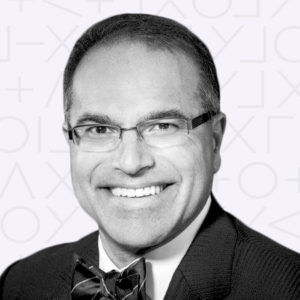As Calyx welcomes Dr. Stephen M. Bravo as its Chief Medical Officer, we discuss this new role and how he will draw upon his 30-year career in Neuroradiology, Musculoskeletal Radiology, and Interventional Radiology to bring efficiencies to the clinical trial process.
What do you hope to achieve through your new position as Chief Medical Officer at Calyx?
Throughout my years in clinical research in the Americas as well as England, I’ve spotted many opportunities to realize efficiencies in how clinical research is conducted. I’ve been able to introduce some improvements within local clinical trial settings but am motivated to help bring about more wholesale improvements in how drugs are brought to market. I’ll be leading Calyx’s scientific, medical, and clinical teams in defining solutions that deploy technology to improve decision making, streamline processes, and eliminate waste.
I’ll also play a role in helping Calyx expand its capabilities with offerings geared to specific therapeutic areas – sometimes through collaboration with partners. There are many therapy areas where new technologies can be used to identify at-risk patient populations, diagnose disease, and stratify patients for treatment.

“I envision technology being used not only to improve the objectivity and reproducibility of radiologic interpretations, but also to demonstrate to payers how a therapy can be targeted to those patients who will respond best.”
– Stephen M. Bravo, MD
Is it unusual to have a Chief Medical Officer role within a technology company?
Yes, I believe it’s quite forward thinking. Most technology companies have Chief Scientific Officers, but they’re still missing the perspective of the end user, the clinician.
I’ve been a Principal Investigator and understand the needs of the industry’s clients (prescribers). This begins with ways to use technology to increase the scientific rigor of trials and extends to talking with pharma CMOs about the best ways to commercialize their products and overcome obstacles to reimbursement and adoption.
How will your background in radiology be applied at Calyx?
Calyx has formed a Scientific Consulting program to optimize imaging processes and outcomes to accelerate the development of new medical treatments – a mission that is near and dear to me. I’ll be advising our biopharmaceutical clients on the use of imaging biomarkers and choosing the best image acquisition strategy and technology to help them meet their clinical development objectives.
What have you observed about the adoption of technology in clinical research?
Unfortunately, I think the clinical development industry has been slower to adopt technology than has clinical practice. Many companies have fallen into the trap of doing things a certain way, just because it’s familiar and has become the default methodology. Calyx was formed to disrupt the status quo with new technology, and part of my role will be to help clients overcome their resistance to being early adopters of tools that will improve data collection, management, analysis, and submission.
How will you stay abreast of client needs and stay close to clinicians?
Calyx’s Engage program, which is designed to regularly capture input from clients across the company’s product line, will certainly give me insights, but I’ll, of course, be maintaining the close relationships I’ve formed over the years with clinicians and academics across the country. I’ll also continue to participate in local research and will remain an active member of scientific and medical societies.
How do you envision that technology will support clinical development in the future?
I see technology becoming more central to trial protocols as well as to data analysis. In vivo biomarkers are going to be exceptionally important not only for gaining regulatory approval for drugs, but also in helping to delineate those patients who will benefit most from a new drug. The goal will be to eliminate the guess work, making drugs more efficacious and cost effective.
Just as a for instance, technology can be used to improve the objectivity and reproducibility of radiologic interpretations as well as to demonstrate to payers how a therapy can be targeted to those patients who will respond best. This will remove enormous costs from the healthcare system.
Dr. Bravo leads Calyx’s scientific, medical, and clinical groups in evolving the Calyx reader model and in defining solutions and services that meet the industry’s needs today and as the field of clinical research continues to evolve.
















